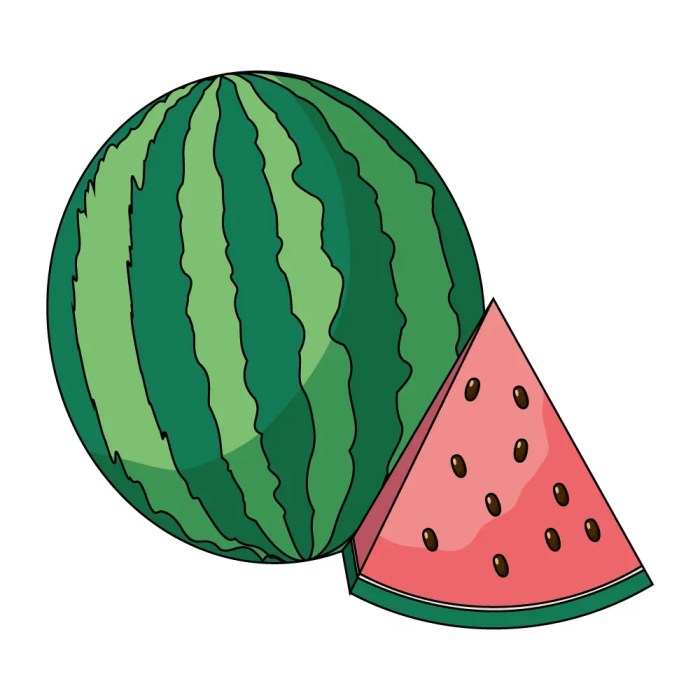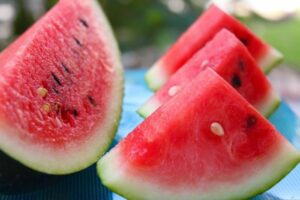How to draw a watermelon – Embark on a captivating artistic journey with our comprehensive guide on how to draw watermelons. From capturing their juicy essence to mastering their intricate textures, this tutorial will guide you through every step, transforming you into a watermelon drawing maestro.
Whether you’re a seasoned artist or just starting your creative adventure, this guide will provide you with the knowledge and techniques to create stunning watermelon drawings that will leave you craving for more.
Introduction: How To Draw A Watermelon
Drawing watermelons is an important skill that can benefit artists of all levels. Watermelons are a popular subject for still life paintings and drawings, and they can also be used to create fun and whimsical illustrations. Learning to draw watermelons can help you to improve your observational skills, your understanding of light and shadow, and your ability to create realistic textures.
Benefits of Learning to Draw Watermelons
There are many benefits to learning to draw watermelons. Some of the most notable benefits include:
- Improved observational skills: Drawing watermelons requires you to pay close attention to the shape, size, and texture of the fruit. This can help you to develop your observational skills, which will benefit you in all areas of your artwork.
- Understanding of light and shadow: Watermelons are a great subject for studying light and shadow. The curved surface of the fruit creates a variety of highlights and shadows, which can help you to understand how light interacts with different objects.
- Creating realistic textures: The skin of a watermelon has a unique texture that can be challenging to draw. By learning to draw watermelons, you can develop your skills in creating realistic textures.
Materials and Preparation
To embark on the artistic journey of capturing the essence of a watermelon, it is imperative to assemble the necessary tools and prepare them meticulously. The following materials will serve as your faithful companions in this creative endeavor:
- Drawing Paper: Choose a high-quality paper with a smooth surface, ensuring that your strokes glide effortlessly across its expanse.
- Pencils: A range of pencils, from soft to hard, will provide you with the versatility to create both delicate and bold lines.
- Eraser: A trusty eraser will stand by your side, allowing you to rectify any missteps along the way.
- Sharpener: Keep your pencils sharp, ensuring precision in every stroke.
- Ruler: For precise measurements and straight lines, a ruler will be your indispensable guide.
- Coloring Mediums: Watercolors, colored pencils, or markers—the choice is yours. These vibrant hues will bring your watermelon to life.
Preparation
Once your materials are gathered, take a moment to prepare them for the task ahead:
- Sharpen Your Pencils: Begin by sharpening your pencils, ensuring that their tips are fine and ready to dance upon the paper.
- Arrange Your Materials: Organize your materials within easy reach, creating a harmonious workspace that fosters creativity.
- Protect Your Surface: Place a protective sheet beneath your paper to safeguard your work surface from stray marks.
- Set the Mood: Find a comfortable and inspiring setting, where your imagination can soar freely.
Basic Shapes and Proportions
The basic shapes that make up a watermelon are a sphere and a cylinder. The sphere represents the main body of the watermelon, while the cylinder represents the stem.
The proportions of these shapes vary depending on the variety of watermelon. However, in general, the sphere is much larger than the cylinder.
Shape and Size
The shape of a watermelon is typically round or oval. The size can vary depending on the variety, but most watermelons are between 10 and 20 pounds.
Stem and Rind
The stem of a watermelon is typically green and attached to the top of the fruit. The rind is the outer layer of the watermelon and is typically green or yellow.
Flesh and Seeds
The flesh of a watermelon is typically red or pink and is very juicy. The seeds are black and are located in the center of the fruit.
Shading and Detailing

Shading and detailing are crucial for adding depth and realism to your watermelon drawing. Let’s explore some techniques and tips for achieving this.
Shading Techniques
– Hatching: Create parallel lines that follow the contours of the watermelon, varying the spacing and darkness to create shading.
– Cross-hatching: Similar to hatching, but the lines are perpendicular to each other, creating a more textured effect.
– Stippling: Use small dots to build up the shading gradually, creating a subtle and smooth effect.
Adding Details
– Highlight: Use a light-colored pencil or eraser to create highlights on the areas that catch the light.
– Shadows: Use a darker pencil to add shadows in the areas that don’t receive direct light, creating a sense of depth.
– Texture: Add small lines or dots to represent the rough texture of the watermelon rind.
– Seeds: Draw small, oval-shaped seeds inside the watermelon using a black or dark brown pencil.
Color and Texture
![]()
Watermelons exhibit a vibrant color palette that primarily consists of a deep green rind and a juicy, crimson interior. The rind’s green hue varies in intensity, ranging from a light, almost emerald shade to a darker, forest green. The interior flesh, on the other hand, boasts a luscious red color, which can vary from a pale pink to a deep, almost burgundy shade. These contrasting colors create a visually appealing and recognizable fruit.
In terms of texture, watermelons possess a smooth, waxy rind that protects the delicate flesh within. The flesh itself is tender and juicy, with a crisp, refreshing bite. The seeds, which are typically black or brown, add a slight crunch to the overall texture.
Variations in Color and Texture
While the classic green and red combination is most commonly associated with watermelons, there are several variations in color and texture that can be found across different cultivars. Some watermelons have a yellow or orange rind, while others may have a striped or mottled pattern. The flesh can also vary in color, with some varieties exhibiting a yellow or orange interior. In terms of texture, some watermelons may have a softer, more delicate flesh, while others may have a firmer, more fibrous texture.
Composition and Perspective
Composition refers to the arrangement of elements within a drawing to create a visually pleasing and balanced image. It involves understanding and applying principles such as the rule of thirds, leading lines, and negative space to guide the viewer’s eye and create a sense of depth and interest.
Perspective, on the other hand, deals with the illusion of depth in a two-dimensional drawing. By understanding the principles of perspective, artists can create the appearance of three-dimensional objects on a flat surface, making the drawing more realistic and engaging.
Creating Perspective
- One-Point Perspective: Involves a single vanishing point on the horizon, towards which all lines recede. This technique is suitable for drawing objects or scenes with a strong sense of depth along a single axis.
- Two-Point Perspective: Utilizes two vanishing points on the horizon, creating a more dynamic perspective with lines receding in two directions. This technique is ideal for drawing buildings, cityscapes, or other objects with complex angles.
- Three-Point Perspective: The most complex form of perspective, involving three vanishing points: one on the horizon and two others above and below it. This technique allows for the depiction of objects or scenes with a strong sense of verticality or aerial perspective.
Advanced Techniques
Tips for Drawing Watermelons in Different Styles
Drawing watermelons in different styles adds variety and interest to your artwork. Experiment with these techniques to create unique and expressive pieces:
- Realistic Style: Focus on capturing the details and textures of a real watermelon, including the bumps, ridges, and variations in color.
- Cartoon Style: Simplify the shapes and exaggerate the features of the watermelon for a fun and whimsical look.
- Abstract Style: Break down the watermelon into its basic shapes and colors, creating a simplified and geometric representation.
- Impressionistic Style: Use loose brushstrokes and vibrant colors to convey the overall impression of a watermelon, rather than the specific details.
Advanced Techniques: Blending and Layering
Blending and layering are essential techniques for adding depth and realism to your watermelon drawings:
- Blending: Use a soft brush or blending stump to smooth out transitions between colors and create a more natural look.
- Layering: Apply multiple layers of paint or pencil to build up the colors and textures of the watermelon, adding depth and interest.
Practice and Refinement

To enhance your drawing abilities, regular practice is crucial. Just like a sculptor who refines their skills through constant molding and shaping, practicing drawing helps you develop muscle memory and improves your hand-eye coordination.
To refine your drawing skills, consider the following:
Drawing from Observation, How to draw a watermelon
- Sketch real-life objects or scenes to enhance your observational skills and capture the nuances of form and texture.
- Pay attention to details, proportions, and lighting, and strive to accurately represent what you see.
Experiment with Different Techniques
- Explore various drawing techniques such as cross-hatching, stippling, and blending to add depth and texture to your drawings.
- Experiment with different drawing tools like pencils, charcoal, and markers to discover their unique capabilities.
Seek Feedback and Critique
- Share your drawings with others and ask for constructive criticism to identify areas for improvement.
- Attend workshops or classes to learn from experienced artists and gain insights into different approaches and techniques.
Outcome Summary
As you continue to practice and refine your skills, you’ll discover the endless possibilities of watermelon drawing. Experiment with different styles, incorporate them into imaginative compositions, and let your creativity flow freely. Remember, the true beauty of art lies in the joy of the creative process itself. So grab your pencils, unleash your imagination, and let’s dive into the world of watermelon drawing!
Helpful Answers
What are the key benefits of learning to draw watermelons?
Drawing watermelons not only enhances your artistic skills but also improves your observation, hand-eye coordination, and ability to capture the nuances of nature.
How do I choose the right materials for drawing watermelons?
Select pencils with varying grades of hardness, an eraser, a sharpener, and high-quality paper that can handle blending and shading.
What are the basic shapes and proportions to consider when drawing watermelons?
Watermelons are typically depicted as ovals or spheres. Pay attention to the proportions of the fruit, with the length being slightly longer than the width.







Leave a Comment